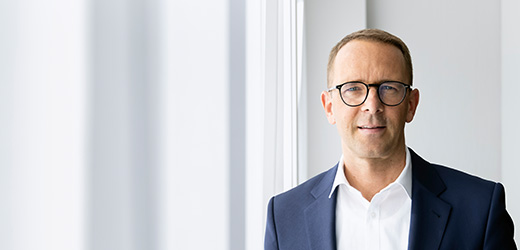Selected Products
The Enablers
Mobility of the Future
It all started with electric current: in 1881, French engineer Gustave Trouvé built the world’s first electrically powered vehicle – his tricycle. Carl Benz did not manage to introduce a vehicle with a combustion engine until five years later. For generations of drivers, his engine concept has remained the only alternative, at least until now. The electric car – emissions free and therefore climate friendly – is enjoying a boom. Ten million electric vehicles are already on the road worldwide. In Germany, every tenth new car is electric. Uniting maximum range, safety and ride quality poses immense challenges to automakers, battery manufacturers and suppliers of materials. Thanks to silicones from WACKER, those challenges can be met. Heat-conducting silicone pastes cool electronic equipment and extend the life of the car’s battery. Flexible silicone gels protect sensitive electrical components and absorb mechanical vibrations and thermal stress. Heat-resistant silicone blends insulate electric motors and wiring harnesses and provide reliable sheathing for adapters and cable connections. Silicones are also essential as sealants in alternative approaches to energy storage, such as fuel cells. WACKER products do important jobs in the cockpit as well: highly transparent silicones, for instance, eliminate glare in XXL displays, making them easy to read – even when the sun is shining.
Sun, Wind and Water
Climate change cannot be stopped without solar and wind power. They are the energy sources of the future. According to the International Energy Agency (IEA), these renewables will meet some 70 percent of global electricity demand by 2050. And WACKER products have a major role to play here. One very compelling example is polysilicon. This shiny silver material is indispensable in photovoltaic systems and thus for generating solar power. Solar arrays consist of other components as well, however: solar cells, electronic systems, cable connections and protective glass all have to be assembled, installed and fixed in place. WACKER provides the silicone rubber sealants and encapsulants needed to do the job. These products, which are robust and resistant to both UV and weathering, help solar arrays produce electricity reliably. The use of silicone-based heat transfer fluids from WACKER is becoming increasingly common in solar thermal processes as well.
Wind turbines are marvels of technology. With diameters now reaching 200 meters or more, their rotors are made using specialty adhesives modified with pyrogenic silica from WACKER. Silicones, too, have many different uses here: they insulate electrical cables and protect housings and sensitive electronic components from moisture, dirt and vibrations. Hydroelectric power plants benefit from WACKER products too. Silicones protect power generators against vibrations and prevent partial discharges in stators.
Alternatives to Meat
The world population is eating more meat than ever. Studies show that increasing meat consumption has a significant environmental impact. There are various approaches to finding new options here, and WACKER offers a range of solutions for alternative proteins.
The amino acid cysteine, for example, is a component of plant-based meat alternatives, where it contributes to a meat-like flavor. WACKER has developed a fermentation-based production process for cysteine. Because its starting products are derived entirely from plants, cysteine from WACKER is strictly vegan and particularly suitable for use in plant-based alternatives.
When plant materials rather than animal products are used in the manufacturing process, texture and consistency pose a challenge as well. Cyclodextrins from WACKER offer a solution. Produced from starch, these sugar molecules interact with the fats and proteins in food, making it possible to improve properties such as texture or spreadability in products like vegan ham salad. Cultured meat is another alternative to conventionally produced meat, and WACKER offers a number of media components for this production process. The culture medium where the cells grow consists of amino acids, among other substances, representing a further application for vegan cysteine from WACKER.
Growth factors – another essential component of the medium – are responsible for stimulating cell growth without the addition of animal components. WACKER is working with Israeli startup Aleph Farms on production processes for growth factors, which are currently major contributors to the cost of manufacturing. High manufacturing costs have been one of the obstacles to commercializing the technology up to now. WACKER aims to offer affordable solutions going forward in order to help cultured meat become established on the market as a sustainable alternative.
Energy-Efficient Construction
The construction industry has a decisive role to play in the fight against climate change. Buildings now account for one-third of global energy consumption. Scientists assume that building emissions will have to be reduced by 80 to 90 percent if we are to limit global warming to 1.5 degrees Celsius. Energy efficiency is the key to achieving that goal. As a partner for the construction industry, WACKER offers a full array of solutions that make construction and housing more sustainable. The use of polymeric binders in tile adhesives, for instance, can save enormous quantities of sand and cement, The amount consumed drops by as much as 80 percent, the actual amount being determined by the individual substrate. Tile adhesives are not the only products that WACKER modifies with polymers, however: polymers also go into waterproofing membranes and interior paints. Powdered wall paints, which WACKER sells under its NEXIVA® brand, contain neither biocides nor preservatives. These paints can be dispersed with water before use. This makes it possible to produce precisely the right amount of paint, resulting in less waste. Exterior insulation and finish systems (EIFS/ETICS) in building facades represent a particularly significant source of potential energy savings. Here they reduce heating costs in cold regions and electricity consumption for cooling in hot climates. Benefits of polymeric binders include improved adhesion between insulating panels. What is more, hydrophobic, breathable silicone resin emulsion paints from WACKER head off moisture saturation, allowing materials to retain their insulating capacity.


